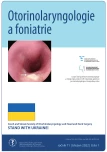Isolated lesion of the hypoglossal nerve as the result of an internal carotid artery aneurysm – case report
Authors:
Tóthová Ž. 1; Sláviková K. 2; Siváková M. 3; I. Vulev 4
; Miroslav Tedla 5,6
Authors‘ workplace:
Lekárska fakulta UK v Bratislave
1; Rádiológia, s. r. o., Bratislava
2; I. neurologická klinika LF UK a UN Bratislava
3; Nemocnica CINRE (Centrum intervenčnej neurorádiológie a endovaskulárnej liečby), Bratislava
4; Klinika otorinolaryngológie a chirurgie hlavy a krku LF UK a UN Bratislava
5; Institute of Cancer and Genomic Sciences, University of Birmingham, United Kingdom
6
Published in:
Otorinolaryngol Foniatr, 71, 2022, No. 1, pp. 44-47.
Category:
Case Reports
doi:
https://doi.org/10.48095/ccorl202244
Overview
A 56-year-old male with arterial hypertension sought for medical help for a sudden unilateral swelling of the oral tongue and changed quality of speech. An ENT examination revealed a lesion of the left hypoglossal nerve. Neurological examinations including brain imaging showed negative results. The MRI of the neck only suggested, the angiography confirmed internal carotid aneurysm in the extracranial portion causing pressure on the hypoglossal nerve. The aneurysm was treated with a flow diverter, which reroutes the blood flow and thus embolises the aneurysm. The aneurysm shrunk, its mass effect disappeared and the function of the nerve fully recovered.
Keywords:
case report – hypoglossal nerve – a. carotis interna – sudden appeared lesion
Sources
1. Čihák R. Anatomie 3. 2. vyd. Praha: Grada 2004.
2. Kim SY, Naqvi IA. Neuroanatomy, cranial nerve 12 (Hypoglossal). In: StatPearls, Treasure Island (FL): StatPearls Publishing LLC 2021.
3. Ambler Z, Bednařík J, Růžička E. Klinická neurologie. 1. část obecná. Praha: Triton 2008.
4. Ambler Z. Neurologie pro studenty lékařské fakulty. 1. vyd. Praha: Karolinum 2001.
5. Finsterer J, Grisold W. Disorders of the lower cranial nerves. J Neurosci Rural Pract 2015; 6 (3): 377–391. Doi: 10.4103/0976-3147.158768.
6. Yoon JH, Cho KL, Lee HJ et al. A case of idiopathic isolated hypoglossal nerve palsy in a Korean child. Korean J Pediatr 2011; 54 (12): 515–517. Doi: 10.3345/kjp.2011.54.12.515.
7. Altun G, Pulathan Z, Hemsinli D. True aneurysms of the extracranial carotid artery: An evaluation of two “giant aneurysms” and the current literature. J Korean Neurosurg Soc 2018; 61 (2): 282–286. Doi: 10.3340/jkns.2017.0404.003.
8. Brain Aneurysm Foundation: Endovascular Treatment. [online]. Dostupné z: https: //www.bafound.org/treatment/endovascular-treatment/.
9. Briganti F, Leone G, Marseglia M et al. Endovascular treatment of cerebral aneurysms using flow-diverter devices: A systematic review. Neuroradiol J 2015; 28 (4): 365–375. Doi: 10.1177/1971400915602803.
10. Vulev I, Šteňo J, Bízik I et al. Aktuálne koncepty endovaskulárnej liečby intrakraniálnych aneuryziem. Vask med 2010; 2 (2): 68–73.
Labels
Audiology Paediatric ENT ENT (Otorhinolaryngology)Article was published in
Otorhinolaryngology and Phoniatrics

2022 Issue 1
Most read in this issue
- Isolated lesion of the hypoglossal nerve as the result of an internal carotid artery aneurysm – case report
- Adaptation and validation of the Czech version of the nasal obstruction symptom evaluation scale (NOSE-cz)
- Microenvironment of squamous cell carcinoma of the head and neck as an analogy of a healing wound
- Coexistent parapharyngeal epithelial-myoepithelial carcinoma and bilateral Warthin’s tumors
